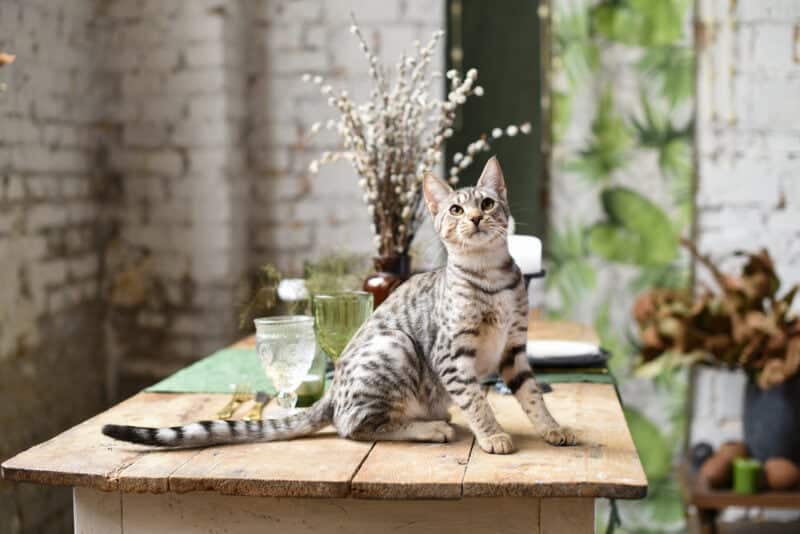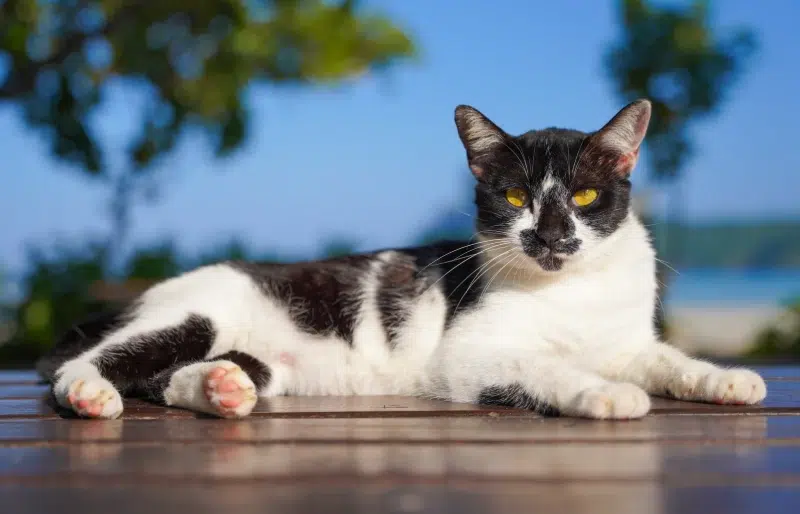Click to Skip Ahead
Savannah cats are magnificent creatures with an irresistibly exotic look. This graceful and slender cat is the result of a cross between an African serval and a domestic cat, which explains their unique appearance and temperament.
Of all the colors accepted by The International Cat Association (TICA), Silver Savannahs are arguably the most sought-after. Their strikingly beautiful coat can have dark or light silver shades and be dotted with round or oval black spots. Their great beauty makes these cats popular but expensive animals. Before you start looking for a breeder, browse this article to learn interesting facts about this sensational breed and their history.
The Earliest Records of the Silver Savannah Cat in History
The earliest records of a Silver Savannah cat in history have not been documented. However, we do know that the Savannah cat breed originated in the mid-1980s when Bengal cat breeder Judee Frank crossed her Siamese Sealpoint with an African Serval named Ernie. These two striking cats gave birth in April 1986 to a beautiful kitten that was named “Savannah.” This kitten received the filial designation (F1). The second generation, F2, was born three years later when Savannah was mated to a Turkish Angora and gave birth to three kittens.
What You Need to Know About the Silver “Color” Coat of Cats
The beautiful silver coat of cats comes from two genes: the agouti gene and the inhibitor gene.
- Agouti: This is the gene responsible for the coat of the tabby cat. The agouti gene is dominant over the non-agouti gene, which means a cat with the agouti gene will not be able to sport a solid-colored coat.
- Inhibitor: This dominant gene suppresses the development of pigment in the hairs of the coat, which generally produces colored hairs only at the tip and with a silvery-white base. In agouti cats, the inhibitor gene will suppress the yellow color and change the base color to white or silver.
The traditional brown-spotted Savannah cat has only the agouti gene, while the Silver Savannah has both.
Since a silver kitten must have at least one parent with these two genes, the first Silver Savannah kitten was most likely born from a cross between a silver domestic cat and a brown-spotted Savannah
How the Silver Savannah Cat Gained Popularity
It’s not hard to see why Silver Savannah cats have captured the hearts of breeders and cat lovers: one look at the beautiful silver-toned coat and graceful silhouette of these cats explains their huge popularity!
However, since the Savannah cat is a relatively recent breed, many people don’t even know that Silver Savannahs exist. Indeed, the “golden” and spotted coat of this breed is the most well-known, which explains people’s excitement when they discover the striking Silver Savannah.
Formal Recognition of the Silver Savannah Cat
TICA registered the Savannah cat in 2001 and gave the breed championship status in 2012. Colors and patterns accepted into the breed standard included black silver-spotted tabby, as well as back, brown-spotted tabby, and black smoke.
Top 3 Unique Facts About the Silver Savannah Cat
1. A Silver Savannah kitten must have at least one silver parent.
This must happen even if there are silver Savannahs in their ancestry.
2. Silver is not actually a color.
It’s a lack of color derived from the inhibitor gene that suppresses the yellowness of the hairs. However, sometimes, golden tones persist in certain areas, which is called “tarnish.”
3. Silver Savannah cats are expensive.
An F1 or F2 Silver Savannah kitten can sell for between $10,000 and $23,000!
Does a Silver Savannah Cat Make a Good Pet?
Silver Savannah cats make great pets, but their coat color doesn’t matter in this regard. Most breeders agree that lower-generation Savannah cats (F5 and up) are generally amazing pets, mainly because they have the exotic looks of their Serval ancestors while still behaving like house cats.
They are loyal to their owners and show love and affection to those around them. They have retained the special traits of older generations (such as strong hunting instincts) but are also endowed with the qualities of domestic cats. They can be trained to walk on a leash and fetch while enjoying leaping onto the tallest cabinet and observing their surroundings from on high. They adapt well to their environment and make excellent cats for families who have enough time to devote to them.
In short, Silver Savannah cats may be highly sought after due to their stunning looks, but that’s not why they make such great companions for any owner lucky enough to have one in their household!
Conclusion
Savannah cats are majestic animals that are popular with cat lovers who appreciate their exotic blend of elegance and strength. They come in a variety of colors, but silver is one of the most popular. The silver coat of these felines is indeed stunning, and the dark spots are simply gorgeous.
If you want to add a Silver Savannah cat to your family, be sure to research the breed and potential breeders thoroughly. You should also ask about the parentage and health of their kittens.
In any case, remember that the most important thing when it comes to choosing a pet is to find a match between you and your animal, no matter the color of their coat.
Featured Image Credit: Yana Vydrenkova, Shutterstock












